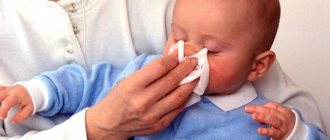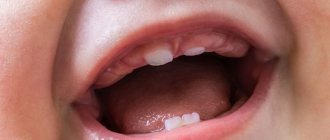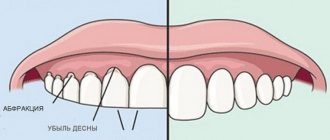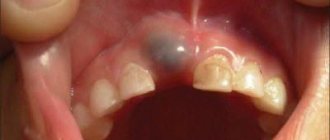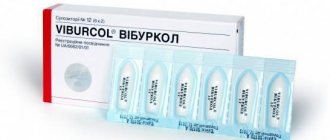How to help your child with constipation
Constipation cannot be ignored, hoping that the baby’s digestion will improve on its own. This condition always causes discomfort to the child. Please note that constipation is not necessarily associated with infrequent bowel movements. A child may poop every day, but at the same time strain, experience pain, and his stool will be formed and hard - and these are already signs of constipation. But if a baby sucks the breast with appetite, sleeps soundly, actively plays and soils his diapers, for example, after a day or two, this is most likely not constipation, but a peculiarity of his digestion.
If you are not sure whether your child’s stool is normal, be sure to consult your pediatrician. There is no need to do an enema, much less use “grandmother’s” recipes involving soap and a thermometer for prevention – “just in case.” (By the way, there are no cases at all for a thermometer and soap; these methods are simply unacceptable!) To help a child with constipation, you need to understand which condition is no longer the norm and determine the reason why the digestion failed. By eliminating it, you will save the child from the consequence - constipation. For a breastfed baby, the norm is yellow, homogeneous, mushy stool from 1-2 to 5-7 times a day. There should be no admixture of mucus and blood in it, only inclusions of white cheesy lumps are allowed. The smell should not be offensive, but simply sour. In bottle-fed children, the stool is denser and darker; as a rule, it happens less often: 1-3 times a day.
The stool of a baby of the first year may change, that is, become more liquid or denser, during transition periods when the child adapts to new conditions, in particular, to a new diet:
For example, constipation may be:
- In the first weeks of life;
- When switching to artificial feeding;
- When changing formula milk;
- During the introduction of complementary foods.
A variety of circumstances can cause constipation - from a simple mistake in diluting the mixture to congenital diseases of the digestive system. Among the most common reasons are:
- Lack of fluid, for example, preparing a more concentrated mixture than recommended by the instructions, or introducing thick complementary foods (for example, when preparing porridge, you took less water to dilute it)
- Physical or psychological discomfort associated with defecation, including irritation of the skin around the anus due to diaper dermatitis.
- Disruption of the intestinal microflora due to an infection or the use of antibacterial drugs can lead to slower peristalsis, that is, a slower movement of food through the intestines.
- Frequent uncontrolled use of enemas and certain medications, such as enzymes or laxatives. All this disrupts the natural course of digestion: it slows down peristalsis, teaching the child to defecate only after additional medicinal or mechanical influence.
- Diseases not directly related to the digestive system: rickets, hypothyroidism, iron deficiency anemia, etc.
Thus, to prevent constipation, a nursing mother needs to drink enough liquid herself: at least 2 liters per day. In the first month of a baby’s life, you need to feed on demand, and when a more or less stable regimen is established and before complementary feeding is introduced, breastfeeding should be given at intervals of no more than 3 hours during the day and 4-5 at night. For a bottle-fed baby, you need to dilute the formula according to the instructions, without violating the proportions of dry product and water.
After introducing complementary foods, regardless of the type of feeding, you need to offer additional water - a total of approximately one feeding per day, that is, 150-200 ml. If a child is prone to constipation, then the first complementary food should be vegetables, not cereal. Carefully monitor the baby's cleanliness: wash rather than use wet wipes when changing a dirty diaper, and if necessary, use diaper cream or baby powder. Do not force him to sit on the potty.
If a baby poops less than once every 36 hours, and a bottle-fed baby does not poop every day, if during the process the child strains or cries with effort, if the feces are formed and hard, contact your pediatrician.
The doctor will determine whether you are constipated or not and will advise you on how to regulate your drinking regime and nutrition in your situation, and if necessary, will prescribe procedures and medications.
It is important!
Do not self-medicate. Constipation is not a harmless disorder; it can lead to serious health problems for the child.
What not to do
First of all, don't wait for the problem to go away on its own. Repeated and prolonged bowel movements in infants always require consultation with a pediatrician.
In addition, it is not recommended:
- feed the baby strictly according to the clock - the baby himself “knows” how much milk he needs and when; feeding on demand promotes normal bowel function and, in addition, stimulates lactation in the mother;
- supplementing breastfeeding after regurgitation: this is a normal act that helps the baby get rid of air and excess food trapped in the stomach;
- supplement the baby with formula or completely switch to artificial feeding, believing that the baby does not have enough milk - the guideline for the fact that he has enough food should be good sleep and normal weight gain;
- frequently use a gas tube, resort to enemas and other methods of stimulating bowel movements;
- use traditional methods of stimulating the rectum, for example, inserting a piece of soap into the anus: soap irritates the mucous membrane and can cause a chemical burn; the laxative effect can be achieved using gentle means, for example, MICROLAX® microenemas;
- take medications without consulting a doctor - all of them can enter the child’s body along with milk and affect his body in general and the functioning of the gastrointestinal tract in particular.
Up to contents
Tummy massage for newborns for constipation
Abdominal massage is effective for preventing and treating constipation. For prevention, it is enough to carry it out at least once a day and place the baby on his tummy more often. If constipation has already occurred, then massage sessions should be performed 2-3 times a day.
You can't massage a full belly. After eating, 2 hours should pass, and before the next meal there should be an hour or at least 30 minutes left. Before performing a massage, calm your baby down and play with him so that the baby is in a good mood. If the child cries and screams, and therefore strains the tummy, massage will not help. In order for massage movements to stimulate bowel movements, they must coincide with intestinal movements during food digestion, the so-called peristaltic waves.
How to do a tummy massage:
- Place your baby on his back on a flat surface, such as a changing table. Make sure your hands are warm.
- Do 5-6 circular strokes of the tummy in a clockwise direction.
- Proceed to counter stroking. To do this, place your right palm on top of the left side of the baby's abdomen, and the back of your left hand on the bottom of the right side. Then simultaneously stroke the baby’s belly in different directions: move your right palm down, and lift the back of your left palm up. Repeat 5-6 times.
- To work the oblique muscles, you need to stroke the sides of the abdomen. Place both palms under the child's lower back, and then, with a grasping stroking motion, move your hands up and forward towards each other, connecting them above the navel. Do 5-6 reps.
- We complete the massage again by circularly stroking the abdomen clockwise with the same number of repetitions - 5-6 times.
What is diabetes mellitus? And what types is it?
Diabetes mellitus is a term that unites a group of diseases accompanied by an increase in glucose (sugar) in the blood. There are many different types of diabetes, but the main two are:
- Type 1, insulin-dependent
- it is also called “childhood” or “young people’s diabetes”, since it mainly affects children or young people; - Type 2, non-insulin dependent
- it is called “diabetes of the elderly”, since it is more common in older people. However, recently it has been diagnosed in young people and even children.
Does a mother's constipation affect her breastfeeding baby?
Errors in the nutrition of a nursing woman can affect the baby’s digestion. To relieve a baby from constipation, his mother will have to reconsider her menu. What dietary disorders can cause constipation?
- lack of water: if the mother drinks little, then where does the body get liquid to produce milk?
- excess foods with a fixing effect: rice, pasta, pastries, white bread, strong tea and coffee;
- lots of milk and dairy products. Constipation may result from intolerance or allergy to cow's milk protein, the most common type of allergy in the first year of life.
- There is little fiber in a woman's diet.
What are the symptoms of diabetes?
One of the first symptoms of diabetes is frequent urination
. Due to the fact that the child begins to go to the toilet frequently, gets up at night, becomes thirsty, and begins to drink more liquid. Parents usually notice that the child begins to drink a lot of water. Due to the fact that the sick child drinks and eats a lot, he begins to lose weight. Next, weakness and fatigue appear.
How is diagnosis carried out? Childhood diabetes is fairly easy to diagnose. We measure blood and urine glucose levels, as well as ketone levels.
Constipation due to rotavirus infection
Mothers are more likely to associate diarrhea with rotavirus infection than constipation. But rotavirus causes inflammation in the intestines and disrupts its functions during illness, so constipation with rotavirus infection is quite possible:
- a sick child eats little, and when vomiting, he loses both fluid and the small amount of food that he was able to eat;
- an increase in temperature causes a large loss of moisture, liquid can be absorbed into the body, including from feces, thickening them;
- The work of digestive enzymes during illness is disrupted, and the number of “harmful” (pathogenic and opportunistic) bacteria increases, because of this, intestinal motility may slow down.
When should you worry about your child?
As a rule, a runny nose in children caused by a virus goes away in 5-7 days, but in some cases green snot persists for a long time. In addition to nasal discharge, the child has other symptoms of intoxication: high fever, body aches. One possible cause of this phenomenon is sinusitis. It is an inflammatory process in the mucous membrane of the paranasal sinuses. Sinusitis can be suspected based on the following signs:
- The child develops headaches.
- Painful sensations of a pulsating nature occur in the cheeks, forehead, a feeling of heaviness in the area of the bridge of the nose, and upper teeth.
- The timbre of the voice changes to a more nasal one.
- The sense of smell decreases.
The most important sign of pathology is a severe runny nose mixed with pus. Nasal discharge becomes profuse, may have a yellow or green tint and an unpleasant odor. As a rule, sinusitis develops against the background of acute respiratory viral infection 2-2.5 weeks after the onset of the disease. Conventional nasal drops and sprays are ineffective in this case.
Before treating a green runny nose in a child with suspected sinusitis, you should consult a doctor. If treated incorrectly, the disease can become chronic. An ENT doctor diagnoses and treats sinusitis.
Based on the diagnostic results, the specialist selects antibacterial drugs that affect the microflora of the respiratory tract, determines the dosage of the drugs and the duration of use.
To relieve inflammation and swelling during sinusitis, inhalations are prescribed. These procedures can be performed in the absence of high fever and acute symptoms of disease. Inhalations are carried out using anti-inflammatory and antiseptic drugs, drugs to maintain immunity. It is important to know: in case of a purulent form of the disease, steam inhalation and heating are prohibited. Heat improves blood flow to the site of pathology, which promotes the proliferation of pathogenic microflora.
Constipation in infants when introducing complementary foods
The introduction of complementary foods, that is, the transition to a qualitatively new type of food, often causes constipation, even if previously everything was in order with the baby’s digestion. Complementary feeding products are recommended to be introduced into children's diets in addition to breast milk or formula from 4 to 6 months. Errors in introducing complementary foods can cause constipation in a baby:
- If complementary foods are introduced to a baby before 4 months, his digestion will not yet cope with other products other than breast milk or its substitutes.
- If complementary foods are introduced on time, but the consistency of the food is too thick, this can also cause constipation. Dense food will have difficulty moving through the still immature intestines. Of course, it’s difficult to make pureed zucchini or broccoli too thick, but with porridge it’s quite possible to miss the mark. Make sure that at the beginning of introducing complementary foods, the porridge is no thicker in consistency than liquid sour cream, and only then gradually transfer the baby to thicker food.
- Constipation can be caused by eating rice porridge as a first food if the child is prone to constipation. For a baby with a dense build, especially if he has stool retention, it is worth choosing vegetables to start complementary feeding. The best porridges for first feeding are buckwheat or corn. Do not forget that porridge at the beginning of complementary feeding should be dairy-free and consist of one type of cereal.
- With the introduction of complementary foods, the baby begins to need additional fluid. Offer him baby water in a bottle, cup or sippy cup throughout the day. Let him drink at least a sip. During the day, the volume of additional liquid should be approximately equal to what the baby eats in one feeding, this is about 150 - 200 ml. If water does not enter the baby’s body additionally, it will be absorbed, including from stool, which will become denser and dryer.
Medications
Can medications be used to relieve constipation in children? Prescription of medications is possible only by a specialist (pediatrician) after examining the child. In some cases, additional diagnostic measures are required.
In most cases, the doctor prescribes the following medications:
- Microlax. The active substance is placed in a special bottle with a soft tip, which must be carefully inserted into the rectum according to the instructions. It acts quickly on the principle of cleansing with an enema.
- Rectal suppositories with glycerin or sea buckthorn oil. These products are made on the basis of natural substances that gently soften stool, provoking bowel movements in about a quarter of an hour.
- "Duphalac" based on lactulose.
- "Prelax" in the form of syrup stimulates peristalsis and normalizes intestinal microflora. Consume before meals.
It should be remembered that the use of such laxatives is possible only in emergency cases. If you do this too often, the child’s body gets used to such “help”, after which difficulties arise with normal bowel movements.
Constipation during teething
Any number of undesirable effects - from a runny nose to an increase in temperature - are not associated with teething. Constipation, like diarrhea, is also among these symptoms. Is it really? Yes and no. The eruption of a tooth from the gum itself, of course, does not cause constipation. However, itching and pain in the place where the tooth is cut bother the baby, his appetite decreases and the temperature may even rise, which leads to increased moisture consumption. The baby eats and drinks less well, which means he poops less often. His stool may become drier and denser due to lack of fluid.
Associated symptoms - to help parents
In addition to constipation at the moment when teeth come in, the child may experience the following unpleasant symptoms:
- temperature increase;
- irritability, aggression, appetite may worsen;
- if, along with these symptoms, the baby develops a gag reflex, you should contact your pediatrician;
- cough, which is caused by excessive salivation;
- ear pain.
Constipation from vitamin D3
Sometimes mothers notice constipation in their babies when they start giving them vitamin D3 for prevention. This is more a coincidence than a consequence of taking the vitamin, since taking it in the prophylactic dose prescribed by the pediatrician does not cause such an effect. But an overdose of vitamin D3 can cause constipation. The fact is that vitamin D3 promotes the absorption of calcium in the intestines. In turn, excess calcium in the intestinal contents leads to the formation of difficult-to-digest compounds that thicken the stool. Do not violate the recommended dosage. With vitamins, as with other medications, more is not better.
What does green diarrhea mean?
Dysbacteriosis is the cause of diarrhea.
If an infant has loose green stools for several days, and the baby is lethargic and restless, then this may be diarrhea, which has developed due to the following reasons:
- Intestinal infection. Occurs under the influence of E. coli, various microbes, dysentery, paratyphoid microorganisms. The first sign is a high temperature. The baby behaves restlessly, often burps, refuses food, and loose stools appear.
- Dysbacteriosis. The most common diagnosis is the gastrointestinal tract. This develops as a result of a disturbance in the composition of the microflora, which leads to malfunctions of the digestive system. In addition to green diarrhea, the child experiences bloating, colic, and skin rashes. The specialist prescribes various types of lactic bacteria and yeast.
- Viral infection. Due to the fact that the child’s immune system is not yet developed, it depends on the state of the intestinal microflora. Therefore, green diarrhea can develop from a viral infection, or even from a simple cold.
- Allergy. Mothers can be triggered by diet, changing formula, or medications. Also, when antibiotics are prescribed, diarrhea is inevitable in most cases.
Psychosomatics for constipation
If the child is only a month old, he will not experience constipation of psychosomatic origin. The central and autonomic nervous systems must mature to fully regulate intestinal function. Psychosomatics as the cause of constipation can be assumed in a child aged a year and a half or older, that is, at the time when he begins to be potty trained. Constipation for psychosomatic reasons can occur if:
- the baby has already experienced pain during bowel movements and is afraid of its repetition, so he holds back stool;
- parents force the child to sit on the potty, but this is unpleasant and scary for him;
- parents scold or punish the child for dirty and wet pants;
- there is an unfavorable emotional situation in the family, poor relationships between parents, a negative attitude towards the child;
- the child went to kindergarten or changed children's group. Constipation can be caused both by stress and by the fact that the baby is embarrassed to go to the potty in the presence of other children and other adults (teachers, nannies).
Almost all children experience constipation. For some these are isolated cases, for others they are regular. Parents should know what can cause constipation and how to deal with it.
So
- To help a child with constipation, first of all, sufficient fluid intake will help: in the form of an additional portion of water, both before and during the period of introducing complementary foods. You cannot use medications, enemas, or folk remedies without a doctor’s prescription.
- To prevent and treat constipation, it is worth mastering tummy massage techniques: circular, counter strokes and stroking the lateral sections of the abdomen.
- Constipation in a mother can cause the same digestive problems in a breastfed baby.
- Rotavirus infection can also cause constipation in a child.
- The period of increased risk of constipation is the introduction of complementary foods.
- During teething, constipation can be caused by poor appetite and loss of moisture due to increased body temperature.
- Prophylactic doses of vitamin D3 do not cause constipation, unlike an overdose.
- Psychosomatics as a cause of constipation begins to play a role when the child reaches the age of potty training, that is, from a year and a half and older.
(0 ratings; article rating 0)
Share Share Share
Green stool in a child after one year
Allergies provoke green stools.
Green stool in a child, no matter what age, should always have a logical explanation for its origin.
If in the first months of life he speaks of disturbances in the digestive system, then in children after 1 year of age he speaks of the presence of infections. Other factors that can cause green stools:
- congenital pathologies of the digestive tract;
- development of infections;
- disruption of the immune or endocrine system;
- staphylococcal infection
- presence of intestinal parasites;
- taking certain medications
- allergy.
In any case, if the color of the stool changes, you need to be examined by a doctor and take tests to diagnose the disease and prescribe surgical treatment.
